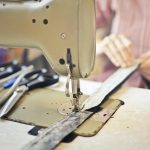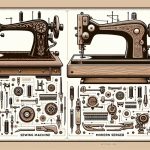Are you new to the world of sewing and wondering what the difference is between a lockstitch and a chain stitch? Both techniques are commonly used in sewing, but they have distinct characteristics that make them suitable for different types of projects.
In this article, we’ll give you a comprehensive overview of lockstitch and chain stitch, including their formation, characteristics, and differences, so you can confidently choose the right technique for your next sewing project.
Lockstitch and chain stitch are two of the most popular types of stitching used in sewing machines today. They differ in the way they are formed and their resulting characteristics. Knowing the differences between the two can help you choose the best type of stitch for your project, whether you’re making a garment, a quilt, or any other sewing project.
So, let’s dive into the world of lockstitch and chain stitch and learn more about their unique features.
Table of Contents
Overview of Lockstitch and Chain Stitch
Want to know the difference between lockstitch and chain stitch? Let’s get started with an overview of these two popular sewing techniques.
Lockstitch is a common type of stitch used in sewing machines. It’s formed by two threads: one from the needle and the other from the bobbin, which interlock in the middle of the fabric. This results in a strong, durable stitch that’s commonly used in garment manufacturing. Lockstitch is also used for embroidery and quilting.
On the other hand, chain stitch is created by looping a single thread through the fabric, forming a chain-like pattern. It’s a more decorative stitch, often used in embroidery, as well as in the construction of some types of garments, such as denim jeans. Chain stitch isn’t as strong as lockstitch, but it allows for more flexibility in the fabric, making it ideal for stretchy materials.
Lockstitch and chain stitch are two different sewing techniques with their own unique characteristics. Lockstitch is stronger and more commonly used for garment construction, while chain stitch is more decorative and ideal for stretchy fabrics. Understanding the differences between these two techniques can help you choose the right one for your sewing project.
Lockstitch: Formation and Characteristics
You’ll be amazed at how tightly your fabric is held together with this stitch, giving you a sense of security and peace of mind. The lockstitch is formed by interlocking two threads, one from the top and one from the bottom, creating a strong and durable stitch. This stitch is commonly used in sewing machines, and it’s the most common type of stitch used in garment construction.
One of the main characteristics of the lockstitch is that it’s reversible, meaning it can be undone if necessary. This is important when making adjustments or repairs to the garment. Another advantage of the lockstitch is that it doesn’t unravel easily, making it ideal for seams that will undergo stress or tension.
However, this stitch does require a lot of thread, as both the top and bottom threads must be long enough to interlock and create a strong stitch.
Overall, the lockstitch is a reliable and versatile stitch that has become a staple in garment construction. Its tight formation and durability make it an excellent choice for seams that will undergo stress or tension. So if you’re looking for a strong and secure stitch that will hold up over time, the lockstitch is definitely worth considering.
Chain Stitch: Formation and Characteristics
Let’s talk about chain stitch! This stitch is formed by looping the thread back on itself, creating a chain-like appearance.
One of the benefits of chain stitch is its flexibility and stretchability, making it great for use in embroidery, applique, and decorative stitching. So if you’re looking to add some unique flair to a garment or create a beautiful embroidered design, chain stitch is a versatile option to consider.
Looping of Thread Back on Itself
Looping of thread back on itself is a common characteristic of chain stitching, creating a unique texture and appearance that cannot be replicated by lockstitching.
This looping occurs because the needle thread forms a loop on the underside of the fabric, which is then caught by the looper thread and pulled back through the fabric, creating a chain of loops on the top side of the fabric. This chain of loops gives chain stitching its signature look, and also allows it to be easily undone if necessary.
However, this looping also makes chain stitching less durable than lockstitching. Because the threads are not interlocked as tightly as they are in lockstitching, chain stitching is more likely to come undone over time.
This is why lockstitching is often used in applications where strength and durability are important, such as in the construction of heavy-duty fabrics and leather goods. Nonetheless, the unique appearance of chain stitching continues to make it a popular choice in many applications, from embroidery and quilting to decorative topstitching on garments and accessories.
Flexibility and Stretchability
With its ability to bend and stretch without breaking, the flexibility of chain stitching makes it a popular choice for garments and accessories that require movement. Unlike lockstitch, which creates a rigid seam, chain stitching allows for some give and take in the material.
This makes it ideal for items like t-shirts, leggings, and activewear, which need to stretch and move with the wearer. Another advantage of chain stitching is its stretchability. Because the thread loops back on itself in a continuous chain, the stitches can stretch along with the fabric without breaking.
This is especially important in items like swimwear, which are exposed to water and frequent stretching. The flexibility and stretchability of chain stitching make it a versatile choice for many types of clothing and accessories.
Use in Embroidery, Applique, and Decorative Stitching
Now that you know about the flexibility and stretchability of lockstitch and chain stitch, let’s talk about their use in embroidery, applique, and decorative stitching. These stitches aren’t just functional but also very versatile when it comes to adding some flair to your projects.
Here are three ways lockstitch and chain stitch can be used for decoration:
-
Embroidery: Lockstitch and chain stitch can be used to create intricate and detailed embroidery designs on fabric. The lockstitch’s great for filling in large areas with solid colors while the chain stitch is perfect for outlining and creating delicate patterns.
-
Applique: If you wanna add some texture to your fabric, applique’s the way to go. Both lockstitch and chain stitch can be used to attach applique pieces to fabric, and they both create a secure and durable bond.
-
Decorative stitching: Finally, lockstitch and chain stitch can be used to create decorative stitching on the surface of fabric. This can be anything from simple lines and shapes to intricate patterns and designs. The possibilities are endless!
Differences Between Lockstitch and Chain Stitch
If you want a durable and strong stitch, go for the lockstitch over the chain stitch. The lockstitch is made by interlocking two threads, one from the needle and one from the bobbin, creating a secure and tight stitch. On the other hand, the chain stitch is made by looping the thread back on itself, which can result in a weaker and more easily unraveled stitch.
Another difference between lockstitch and chain stitch is their appearance. The lockstitch creates a neat and uniform stitch with no visible loops on either side of the fabric. Meanwhile, the chain stitch creates a distinct chain-like pattern with loops on one side and straight stitches on the other. This can be a desirable effect for some decorative stitching or embroidery, but it may not be suitable for more functional sewing projects.
It’s important to note that lockstitch machines are more common than chain stitch machines because of their versatility and strength. Lockstitch machines can sew a wider range of fabrics and are better equipped to handle thicker materials. On the other hand, chain stitch machines are typically used for more specialized applications, such as creating decorative stitching on clothing or creating seams in knitwear.
When to Use Lockstitch
Consider using a lockstitch machine for sewing projects that require a neat and uniform stitch with no visible loops on either side of the fabric. This type of stitch is created by interlocking the upper and lower threads, resulting in a strong and secure seam.
Lockstitch machines are commonly used in the garment industry for sewing clothing and accessories, as well as in the manufacturing of home decor items like curtains and bedding. They are also a good choice for projects that require precise stitching, such as quilting and embroidery.
The stitch length can be adjusted to create a tight or loose stitch, depending on the fabric and desired effect. Additionally, lockstitch machines can handle a variety of fabrics, including lightweight and heavy-duty materials. This versatility makes them a popular choice for both professional and hobbyist sewers.
When using a lockstitch machine, it’s important to choose the correct thread and needle for the fabric being sewn. Using a high-quality thread and needle will ensure that the stitches are strong and durable. It’s also important to practice proper maintenance and cleaning of the machine to keep it running smoothly and prevent any issues with the stitching.
With the right tools and techniques, a lockstitch machine can help you create beautifully sewn projects with a professional finish.
When to Use Chain Stitch
One advantage of the chain stitch is that it allows for easy removal of the stitches if needed. This makes it a great option for temporary stitching, such as basting or tacking. If you need to hold two pieces of fabric together temporarily before permanently sewing them, a chain stitch can easily be removed without damaging the fabric.
Additionally, chain stitching is ideal for decorative embroidery, as it creates a unique, textured effect. Another benefit of chain stitching is its ability to stretch and move with the fabric. This makes it a popular choice for sewing knit fabrics, as the stitch can expand and contract with the material. Chain stitching is also commonly used in sewing activewear and outdoor gear, as it can withstand high levels of movement and stress without breaking.
However, a disadvantage of chain stitching is that it is not as strong as a lockstitch. The individual loops of the chain stitch can easily come undone if one loop is broken. This makes it a poor choice for seams that will experience a lot of wear and tear, such as in jeans or heavy-duty bags. If you need a strong, durable seam, a lockstitch is the better option.
- What Is Pochampally Ikat? a Journey to India’s Silk City - June 27, 2025
- What Is Pochampally Ikat? a Journey to India’s Silk City - June 27, 2025
- What Is Pochampally Ikat? a Journey to India’s Silk City - June 27, 2025





